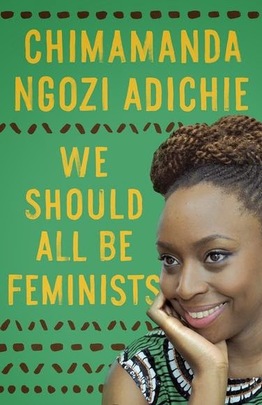Reviewed by Olivia Kramer

We Should All Be Feminists is actually a version of the author, Chimamanda Ngozi Adichie’s, speech on feminism and gender equality on Ted translated into a book. But the quality of her words and the influence and message they promote make up for the book’s lack of quantity. Throughout the less than 60 page speech, Chimamanda speaks of the taboo of feminism in Nigeria and what feminism has evolved to in modern day society. She also addresses numerous misconceptions on feminism and feminists and exploits the ignorance and misogyny behind these misbeliefs. Overall, I thought the book/speech was incredible and highlighted some of the key points in feminism.
At the beginning of the book Chimamanda says,” You know you’re a feminist. It was not a compliment. I could tell from his tone- the same tone in which a person would say “ You’re a supporter of terrorism.” She continues the chapter by comparing gender roles in society and how women are forced to fill a mold society has crafted for them while men don’t need to live up to such a strenuously infeasible expectation. She also acknowledges the double standard of how women seem to have to behave, dress, and talk a certain way to be taken seriously in politics or society while men seem to have no stress to fulfill a similar conjecture. I really enjoyed this beginning section of the story because, though I’ve always known of the existence of sexism and misogyny, I’ve never realised just how much it impacts women in society today.
Another part of the book that I liked was when Chimamanda spoke in depth of the taboos of being a feminist living in Nigeria and much of the world. “... a Nigerian woman told me that feminism was not our culture, that feminism was un-African…” I loved this part of the story as she described her encounters with the openly misogynistic beliefs of others not because of the message their words promote, but because her eternally optimistic view on feminism was unwavering as she took ridicule. I also enjoyed the part towards the middle of the book where she had been discussing sexism’s double standards in society with her friend, Louis, who said he didn’t see why she thought that things were harder and different for women when they had the real power, “ bottom power. ” “Bottom power” is a reference, originating in Nigeria, which is most basically when a woman becomes rich or successful through a man by seducing him. “ A woman who uses her sexuality to get favors from men.” Not prostitution, but when a woman’s success is attributed to a man ( example: if a woman is well known and lives in a mansion but only because her husband is even more well known and essentially the main source of income.) After this comment, Chimamanda, talks about how this is not true power that the woman has because she is so financially heavily dependent on her husband that if something were to happen to him she most likely wouldn’t be able to live the way she previously did when her husband earned a stable salary. I enjoyed this because it opened my eyes to some of the “parasitic” roles women are forced to play in society.
My favorite part though was towards the end of the book where Chimamanda compared women’s struggles in politics, economy, and society to men’s struggles in similar situations. “ I spent half an hour debating over what I should wear to be taken seriously and then I realized that there has probably never been a man in this same dilemma because when a man speaks his voice is heard.” I thought this statement spoke pretty strongly to me because it showed how women are always judged on their looks and what their appearance says about them not what they actually say and promote. While on the other hand, though I’m not saying a man wouldn’t be ridiculed if his wardrobe was ludicrously inappropriate, it is much easier for him to get his point across. Because men are not forced to rely so heavily on their sexuality and appearance to prevail in society and our culture ( hence: bottom power.) I enjoyed this part because I thought it really showed the double standards we build ourselves to believe our acceptable.
Overall, I thought this was an incredible book and would recommend it to anyone in need of a quick read. Though I think all the books that I read are exceptional this one truly stood out to me and I think really influenced me and opened my eyes to many of the issues around me that I had become oblivious to. I know this entire book review might just seem like a pointless rant of appraisal to the book, We Should All Be Feminists, but I truly have been trying to find a flaw in the speech but I haven’t been able to find any. I do think it left out one or two issues that women face ( the wage gap) but I guess if she listed all of the issues it would make her speech to long and tedious. Either way, I would highly recommend this book.
At the beginning of the book Chimamanda says,” You know you’re a feminist. It was not a compliment. I could tell from his tone- the same tone in which a person would say “ You’re a supporter of terrorism.” She continues the chapter by comparing gender roles in society and how women are forced to fill a mold society has crafted for them while men don’t need to live up to such a strenuously infeasible expectation. She also acknowledges the double standard of how women seem to have to behave, dress, and talk a certain way to be taken seriously in politics or society while men seem to have no stress to fulfill a similar conjecture. I really enjoyed this beginning section of the story because, though I’ve always known of the existence of sexism and misogyny, I’ve never realised just how much it impacts women in society today.
Another part of the book that I liked was when Chimamanda spoke in depth of the taboos of being a feminist living in Nigeria and much of the world. “... a Nigerian woman told me that feminism was not our culture, that feminism was un-African…” I loved this part of the story as she described her encounters with the openly misogynistic beliefs of others not because of the message their words promote, but because her eternally optimistic view on feminism was unwavering as she took ridicule. I also enjoyed the part towards the middle of the book where she had been discussing sexism’s double standards in society with her friend, Louis, who said he didn’t see why she thought that things were harder and different for women when they had the real power, “ bottom power. ” “Bottom power” is a reference, originating in Nigeria, which is most basically when a woman becomes rich or successful through a man by seducing him. “ A woman who uses her sexuality to get favors from men.” Not prostitution, but when a woman’s success is attributed to a man ( example: if a woman is well known and lives in a mansion but only because her husband is even more well known and essentially the main source of income.) After this comment, Chimamanda, talks about how this is not true power that the woman has because she is so financially heavily dependent on her husband that if something were to happen to him she most likely wouldn’t be able to live the way she previously did when her husband earned a stable salary. I enjoyed this because it opened my eyes to some of the “parasitic” roles women are forced to play in society.
My favorite part though was towards the end of the book where Chimamanda compared women’s struggles in politics, economy, and society to men’s struggles in similar situations. “ I spent half an hour debating over what I should wear to be taken seriously and then I realized that there has probably never been a man in this same dilemma because when a man speaks his voice is heard.” I thought this statement spoke pretty strongly to me because it showed how women are always judged on their looks and what their appearance says about them not what they actually say and promote. While on the other hand, though I’m not saying a man wouldn’t be ridiculed if his wardrobe was ludicrously inappropriate, it is much easier for him to get his point across. Because men are not forced to rely so heavily on their sexuality and appearance to prevail in society and our culture ( hence: bottom power.) I enjoyed this part because I thought it really showed the double standards we build ourselves to believe our acceptable.
Overall, I thought this was an incredible book and would recommend it to anyone in need of a quick read. Though I think all the books that I read are exceptional this one truly stood out to me and I think really influenced me and opened my eyes to many of the issues around me that I had become oblivious to. I know this entire book review might just seem like a pointless rant of appraisal to the book, We Should All Be Feminists, but I truly have been trying to find a flaw in the speech but I haven’t been able to find any. I do think it left out one or two issues that women face ( the wage gap) but I guess if she listed all of the issues it would make her speech to long and tedious. Either way, I would highly recommend this book.

 RSS Feed
RSS Feed
